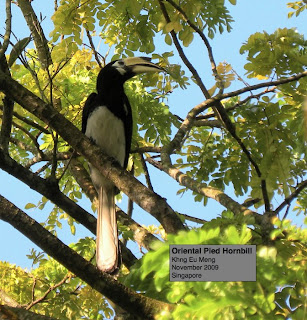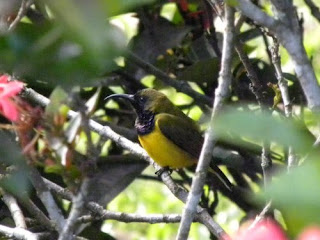December 31, 2009
Today, I made a trip to the hill top park to check these birds out. By the way, Fort Canning is one of the most significant sites of Singapore, as it was said to be the place where Malay chieftans ruled from here and where many ancient Chinese porcelain shards, coins, gold and precious stones jewellery have been unearthed. For more details on the park and what it offers the visitor today, please see: http://www.nparks.gov.sg/cms/index.php?option=com_visitorsguide&task=parks&id=16&Itemid=73
The trip rewarded me with the sighting of not one but a pair of White-bellied Sea Eagle, said to be the largest bird of prey around these parts. Their call was a mix of the call of geese, ducks and screams. One sat still high up on the communication tower while the other flew off in search of food. Mayhaps this a breeding pair and the female must be heavy with eggs as she waited to be fed without lifting a wing.
Here is the pair from the back:
And here's the patient waiting female.

And this is just to show how high a perch she was on.

Calls from Kingfishers, Koel and Sunbirds were heard as I strolled around the top of the hill. I didn't spot the Koel and the Sunbirds, as usual, could never sit still for me to photograph them. A White-collard Kingfisher obliged:
Even if one is not a fan of birds, this park is worth the short climb up. It is lush up there, the air sweetly scented by exotic flowers and leaves. And where the canopy parts you can see the busy town below. I guess that's why the rulers of old stationed themselves up here. Sir Thomas Stamford Raffles had a house built for him here in 1823, but he was never around. He mostly busied himself in Bencoolen or Benkulen in Sumatra, Indonesia. Some of the flora in the park are new to me, like this one:

On the way down, you may pass the Spice Garden where a cocoa tree has begun to bear fruit.

I intend to revisit this park at a time where more birds can be spotted. So watch this space.
To be continued ...























































